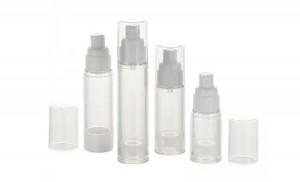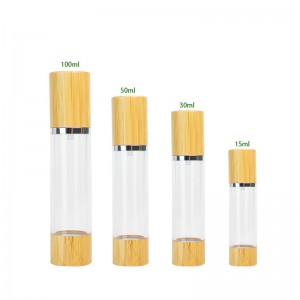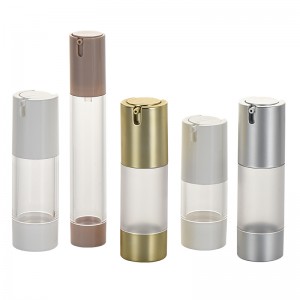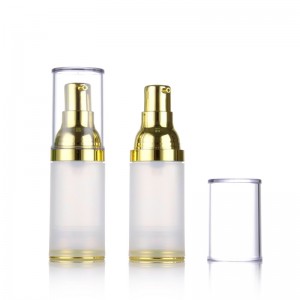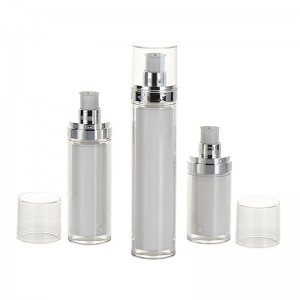This article is organized by Shanghai Rainbow Industry Co., Ltd. The standard content of this article is only for quality reference when purchasing packaging materials for various brands, and the specific standards should be based on the standards of each brand’s own or its cooperating supplier.
ONE
Standard definition
1. Suitable for
The content of this article is applicable to the inspection of various vacuum bottles used in daily chemicals, and is for reference only.
2. Terms and definitions
Definition of surface primary and secondary surfaces: The appearance of a product should be evaluated based on the importance of the surface under normal use conditions;
Main aspect: After the overall combination, the exposed parts that are being paid attention to. Such as the top, middle, and visible parts of the product.
Secondary side: After the overall combination, the hidden parts and exposed parts that are not noticed or difficult to detect. As at the bottom of the product.
3. Quality defect level
Fatal defect: Violating relevant laws and regulations, or causing harm to human health during production, transportation, sales, and use.
Serious defect: refers to the functional quality and safety that are affected by the structural quality, directly affecting the sales of the product or causing the sold product to fail to achieve the expected effect, and causing consumers to feel uncomfortable and react to unqualified products during use.
General defects: Nonconforming defects that involve appearance quality but do not affect the product structure and functional experience, and do not have a significant impact on the product’s appearance, but make consumers feel uncomfortable when using them.
Two
Appearance quality requirements
1. Basic standards for appearance:
The vacuum bottle should be complete, smooth, and free from cracks, burrs, deformation, oil stains, and shrinkage, with clear and full threads; The body of vacuum bottle and lotion bottle shall be complete, stable and smooth, the mouth of the bottle shall be straight, smooth, the thread shall be full, there shall be no burr, hole, obvious scar, stain, deformation, and there shall be no obvious dislocation of the mold closing line. Transparent bottles should be transparent and clear
2. Surface and graphic printing
Color difference: The color is uniform and meets the specified color or is within the range of color plate sealing.
Printing and stamping (silver): The font and pattern should be correct, clear, uniform, and free from obvious deviation, misalignment, or defects; The gilding (silver) should be complete, without missing or misplaced ironing, and without obvious overlapping or serration.
Wipe the printing area twice with gauze soaked in disinfectant alcohol, and there is no printing discoloration or gold (silver) peeling.
3. Adhesion requirements:
Hot stamping/printing adhesion
Cover the printing and hot stamping area with 3M600 shoe cover, flatten and press back and forth 10 times to ensure that there are no bubbles in the shoe cover area, and then tear it off instantly at a 45 degree angle without any printing or hot stamping detachment. Slight detachment does not affect overall recognition and is acceptable. Slowly tear open the hot gold and silver area.
Adhesion of electroplating/spraying
Using an art knife, cut 4-6 squares with a side length of approximately 0.2cm on the electroplated/sprayed area (scratch the electroplated/sprayed coating), stick 3M-810 tape to the squares for 1 minute, and then quickly tear them off at a 45 ° to 90 ° angle without any detachment.
4. Hygiene requirements
Clean inside and outside, no free pollution, no ink stains or contamination
Three
Structural quality requirements
1. Dimensional control
Size control: All assembled finished products after cooling shall be controlled within the tolerance range and shall not affect the assembly function or hinder packaging.
Important dimensions related to function: such as the size of the sealing area at the mouth
Internal dimensions related to filling: such as dimensions related to full capacity
External dimensions related to packaging, such as length, width, and height
The assembled finished products of all accessories after cooling shall be tested with Vernier scale for the size that affects the function and hinders the packaging, and the size of the size accuracy error affects the coordination of the function, with the size ≤ 0.5mm and the overall size that affects the packaging ≤ 1.0mm.
2. Bottle body requirements
The buckle fit of the inner and outer bottles should be tightly clamped in place, with appropriate tightness; The assembly tension between the middle sleeve and outer bottle is ≥ 50N;
The combination of inner and outer bottles should not have friction on the inner wall to prevent scratches;
3. Spray volume, volume, first liquid output:
Fill the bottle with 3/4 colored water or solvent, lock the pump head tightly with the bottle teeth, and manually press the pump head to discharge the liquid in 3-9 times. The spraying amount and volume should be within the set requirements.
Place the measuring cup steadily on the electronic scale, reset to zero, and spray liquid into the container, with the weight of the sprayed liquid divided by the number of times sprayed=the amount sprayed; The spray amount allows a deviation of ± 15% for a single shot, and a deviation of 5-10% for the average value. (The spraying amount is based on the type of pump selected by the customer for sealing the sample or the customer’s clear requirements as a reference)
4. Number of spraying starts
Fill the bottle with 3/4 colored water or lotion, press the pump head cap evenly with the bottle locking teeth, spray no more than 8 times (colored water) or 10 times (lotion) for the first time, or seal the sample according to the specific evaluation standards;
5. Bottle capacity
Place the product to be tested smoothly on the electronic scale, reset to zero, pour water into the container, and use the data displayed on the electronic scale as the test volume. The test data must meet the design requirements within the scope
6. Vacuum bottle and matching requirements
A. Fit with piston
Sealing test: After the product is naturally cooled for 4 hours, the piston and tube body are assembled and filled with water. After being left for 4 hours, there is a sense of resistance and no water leakage.
Extrusion test: After 4 hours of storage, cooperate with the pump to perform an extrusion test until the contents are completely squeezed and the piston can move up to the top.
B. Matching with pump head
The press and spray test should have a smooth feel without any obstruction;
C. Match with bottle cap
The cap rotates smoothly with the thread of the bottle body, without any jamming phenomenon;
The outer cover and inner cover should be assembled in place without any tilting or improper assembly;
The inner cover does not fall off during the tensile test with an axial force of ≥ 30N;
The gasket shall not fall off when subjected to a tensile force of not less than 1N;
After the specification outer cover is matched with the thread of the corresponding bottle body, the gap is 0.1-0.8mm
Aluminum oxide parts are assembled with corresponding caps and bottle bodies, and the tensile force is ≥ 50N after 24 hours of dry solidification;
Four
Functional quality requirements
1. Sealing test requirements
Through vacuum box testing, there should be no leakage.
2. Screw tooth torque
Fix the assembled bottle or jar on the special fixture of the torque meter, rotate the cover by hand, and use the data displayed on the torque meter to achieve the required testing force; The torque value corresponding to the thread diameter should comply with the provisions of the normative appendix. The screw thread of vacuum bottle and lotion bottle shall not slip within the specified rotation torque value.
3. High and low temperature test
The bottle body shall be free from deformation, discoloration, cracking, leakage, and other phenomena.
4. Phase solubility test
No obvious discoloration or detachment, and no misidentification
FIVE
Acceptance method reference
1. Appearance
Inspection environment: 100W cold white fluorescent lamp, with the light source 50~55 cm away from the surface of the tested object (with an illumination of 500~550 LUX). The distance between the surface of the tested object and the eyes: 30~35 cm. The angle between the line of sight and the surface of the tested object: 45 ± 15 °. Inspection time: ≤ 12 seconds. Inspectors with naked or corrected vision above 1.0 and no color blindness
Size: measure the sample with a ruler or a Vernier scale with an accuracy of 0.02mm and record the value.
Weight: Use an electronic scale with a graduation value of 0.01g to weigh the sample and record the value.
Capacity: weigh the sample on an electronic scale with a graduation value of 0.01g, remove the gross weight of the bottle, inject tap water into the Vial to the full mouth and record the volume conversion value (directly inject paste or convert the density of water and paste when necessary).
2. Sealing measurement
Fill a container (such as a bottle) with 3/4 of colored water (60-80% colored water); Then, match the pump head, sealing plug, sealing cover and other related accessories, and tighten the pump head or sealing cover according to the standard; Place the sample on its side and upside down in a tray (with a piece of white paper pre placed on the tray) and place it in a vacuum drying oven; Lock the isolation door of the vacuum drying oven, start the vacuum drying oven, and vacuum to -0.06Mpa for 5 minutes; Then close the vacuum drying oven and open the isolation door of the vacuum drying oven; Take out the sample and observe the white paper on the tray and the surface of the sample for any water stains; After taking out the sample, place it directly on the experimental bench and gently tap the pump head/sealing cover a few times; Wait for 5 seconds and slowly unscrew (to prevent colored water from being brought out when twisting the pump head/sealing cover, which may cause misjudgment), and observe for colorless water outside the sealing area of the sample.
Special requirements: If the customer requests a vacuum leakage test under certain high temperature conditions, they only need to set the temperature of the vacuum drying oven to meet this condition and follow steps 4.1 to 4.5. When the negative pressure conditions (negative pressure value/holding time) of the vacuum leakage test are different from those of the customer, please test according to the negative pressure conditions of the vacuum leakage test finally confirmed with the customer
Visually inspect the sealed area of the sample for colorless water, which is considered qualified.
Visually inspect the sealed area of the sample for colorless water, and colored water is considered unqualified.
If the color water outside the piston sealing area inside the container exceeds the second sealing area (lower edge of the piston), it is considered unqualified. If it exceeds the first sealing area (upper edge of the piston), the color water area will be determined based on the degree.
3. Low temperature testing requirements:
The vacuum bottle and lotion bottle filled with clean water (the particle size of insoluble matter shall not be greater than 0.002mm) shall be put into the refrigerator at -10 ° C~-15 ° C, and taken out after 24h. After recovery at room temperature for 2 hours, the test shall be free of cracks, deformation, discoloration, paste leakage, water leakage, etc.
4. High temperature test requirements
The vacuum bottle and lotion bottle filled with clean water (the particle size of insoluble matter shall not be greater than 0.002mm) shall be put into the incubator within+50 ° C ± 2 ° C, taken out after 24h, and tested to be free of cracks, deformation, discoloration, paste leakage, water leakage and other phenomena after 2 hours of recovery at room temperature.
SIX
Outer packaging requirements
The packaging carton should not be dirty or damaged, and the inside of the box should be lined with plastic protective bags. Bottles and caps that are prone to scratches should be packaged to avoid scratches. Each box is packaged in a fixed quantity and sealed with tape in an “I” shape, without mixing. Each batch of shipments must be accompanied by a factory inspection report, with the outer box labeled with the product name, specifications, quantity, production date, manufacturer, and other contents, which must be clear and identifiable.
Shanghai rainbow industrial co.,ltd provides one-stop solution for cosmetic packaging.If you like our products, you can contact us,
Website:
www.rainbow-pkg.com
Email: vicky@rainbow-pkg.com
WhatsApp: +008615921375189
Post time: Jul-10-2023


